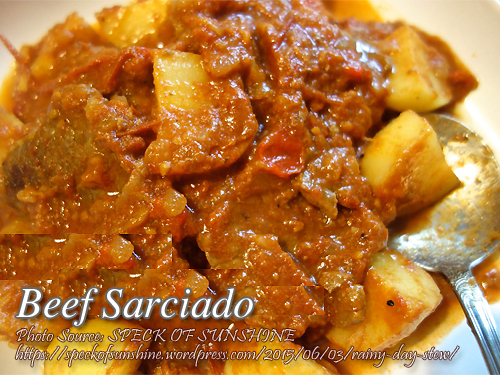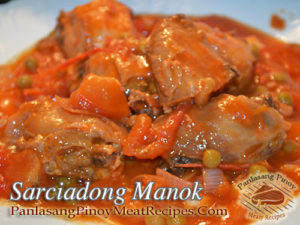Beef sarciado or sarciadong baka is one of the many delicious Filipino dishes with Spanish influence. The common sarciado that we know is the fish sarciado, fried fish stewed in tomatoes and eggs which is very different. Beef sarciado is similar to kaldereta or mechado because of the vegetables used like the garbanzos, green peas and potatoes but the only difference is that sarciado use only fresh tomatoes where kaldereta and mechado use tomato sauce.
Beef Sarciado or Sarciadong Baka
If you’re craving a comforting Filipino dish that’s packed with flavor and history, beef sarciado is the perfect choice. This rich and hearty recipe comes with a unique twist on the more popular sarciado dish, typically made with fish. However, this beef version stands out on its own, offering tender beef short ribs stewed in a medley of fresh tomatoes, garlic, onions, and hearty vegetables like garbanzos, green peas, and potatoes. It’s a comforting meal that brings the flavors of home to your plate.
A Spanish Legacy in Filipino Cuisine
Like many Filipino dishes, the roots of this meal stretch back to the Spanish colonial period, a time when Spanish culinary influences blended with local Filipino ingredients. The word sarciado itself comes from the Spanish term salsa, meaning sauce, reflecting how the dish is bathed in a luscious tomato-based stew. While the more commonly known Fish Sarciado is stewed with tomatoes and eggs, this variation uses only fresh tomatoes, setting it apart from other Filipino tomato-based stews like kaldereta and mechado that typically call for tomato sauce. It’s a dish that has evolved over the years but still keeps that distinct Filipino-Spanish flavor profile alive.
The Heart of the Dish: Tender Beef and Fresh Ingredients
The key to a good Beef Sarciado lies in the quality and tenderness of the beef. For this recipe, short ribs are a popular choice because of their rich, meaty flavor and melt-in-your-mouth texture when cooked properly. The dish starts by boiling the beef with aromatic ingredients like garlic, onions, peppercorns, and bay leaves. Simmering the beef slowly ensures it becomes tender, while also creating a broth that becomes the base of the stew.
Using fresh tomatoes is what gives this dish its unique flavor compared to other Filipino stews. As the tomatoes soften and break down, they create a natural sauce that is sweet, tangy, and savory, perfectly complementing the richness of the beef. It’s this simple, unadulterated use of fresh ingredients that makes this dish truly special.
Cooking Tips for Perfect Results
One of the best things about this recipe is its flexibility. If you’re short on time, you can speed up the cooking process by using a pressure cooker. This cuts down the cooking time of the beef to about 40 minutes, while still achieving that tender, fall-off-the-bone texture. However, if you have the time, slow-cooking the beef on the stovetop will allow the flavors to fully develop, giving the dish a deeper and richer taste.
Once the beef is tender, the next step is to sauté garlic, onions, and tomatoes until the tomatoes soften and form the base of the sauce. This part of the cooking process fills your kitchen with the mouthwatering aroma of garlic and onions sizzling in oil, combined with the fresh, earthy scent of tomatoes. It’s these simple yet flavorful ingredients that lay the foundation for the dish’s bold flavor.
A Hearty Stew of Vegetables and Beef
The vegetables used in this dish are an essential part of what makes it so hearty and satisfying. Potatoes, garbanzos (chickpeas), and green peas not only add texture and color to the stew but also soak up the flavorful broth, becoming soft and tender as they cook. These vegetables are often found in other Filipino dishes like kaldereta and mechado, but the use of fresh tomatoes as the base here gives them a different depth of flavor.
When the beef and vegetables come together in the skillet, they simmer in the rich broth, allowing the flavors to meld and the beef to soak up the tangy, savory goodness of the tomatoes. The final result is a stew that’s comforting, flavorful, and deeply satisfying—a perfect dish for sharing with family and friends.
A Comforting Meal for Any Occasion
This hearty dish is versatile enough to be served for lunch, dinner, or even special occasions. It’s a perfect centerpiece for a family gathering or a potluck, served with a generous helping of steamed rice. The savory beef and flavorful vegetables make it a filling and satisfying meal on its own.
For those new to cooking Filipino dishes, this is a great introduction to the rich and varied flavors of Filipino cuisine. While it may take a bit of time to prepare, the steps are simple, and the reward is a dish bursting with flavor. And if you have leftovers, you’re in luck—like many stews, Beef Sarciado tastes even better the next day as the flavors continue to deepen and meld together.
The Flavorful Tradition of Filipino Stews
Beef Sarciado is just one of many tomato-based stews in Filipino cuisine, but it holds its own against more well-known dishes like kaldereta and mechado. It’s a testament to how Filipino cooks have taken ingredients introduced by the Spanish and made them their own, creating a dish that’s uniquely Filipino.
By using only fresh tomatoes, this dish has a lighter, brighter taste compared to the richer, heavier flavor of tomato sauce-based stews. This makes it a great option for those who prefer a more natural, less processed version of traditional Filipino stews. It’s a wonderful reminder of how food evolves, influenced by culture and history, yet still staying true to its roots.
This delicious beef stew is a comforting, flavorful meal that’s perfect for any occasion. Whether you’re a seasoned cook or just starting out, this dish is easy to make and is sure to become a favorite in your kitchen. So gather your ingredients and give this delicious recipe a try—you won’t be disappointed!
How to Cook Beef Sarciado (Sarciadong Baka)
Ingredients
- 1 kilo beef short ribs cut into serving pieces
- 2 pcs medium size onions chopped (for sauteing)
- 1 pc medium size onion quartered (for boiling the meat)
- 5 cloves garlic minced (for sauteing)
- 1 head garlic crushed
- 1 tsp. whole peppercorns
- 1 bay leaf
- 7 medium size tomatoes chopped
- 3/4 cup garbanzos or chickpeas
- 3/4 cup green peas
- 3 pcs medium size potatoes peeled, quartered and fried
- 1/4 cup cooking oil
- 1 tsp. granulated seasoning e.g. Magic Sarap, NamNam
- Salt and pepper
Instructions
How to cook Beef Sarciado:
- In a pot, fill with water just enough to cover the short ribs and add onions, garlic, peppercorns, salt and bay leaf.
- Bring to a boil and remove any scums floating and simmer for about 2 to 3 hours or until the beef is tender.
- A pressure cooker can be used if you want to speed up the cooking process.
- Strain the beef and set aside both the beef and the broth.
- In a skillet, heat the oil and saute garlic until it changes in color then add onions and tomatoes.
- Stir cook and simmer for a few minutes until the tomatoes are soft.
- Pour in 1 cup of beef broth then add in the beef short ribs and season with granulated seasoning, salt and pepper.
- Add in green peas, garbanzos and potatoes and simmer for about 20 minutes or until the dish is cooked.
Notes
Cooking Tips:
Choose Fresh, Ripe Tomatoes
Using fresh, ripe tomatoes is key to creating a flavorful sauce in Beef Sarciado. They provide a natural sweetness and tanginess that balances the richness of the beef. Overripe or canned tomatoes can alter the flavor, so always opt for fresh ones when possible.Slow Simmer for Tender Beef
For melt-in-your-mouth beef, take your time to simmer the short ribs gently. Cooking the beef over low heat for a few hours ensures it absorbs the flavors of the broth and becomes tender. If you're in a hurry, a pressure cooker can speed up the process without sacrificing tenderness.Sauté Aromatics Until Fragrant
When sautéing garlic, onions, and tomatoes, make sure to cook them until they’re fragrant and slightly caramelized. This step enhances the flavor of the dish, creating a deeper, richer base for the stew. Avoid rushing through this part, as it builds the foundation for a flavorful sauce.





